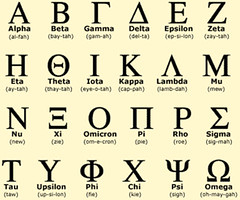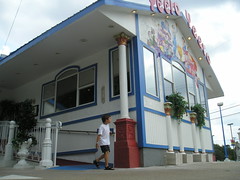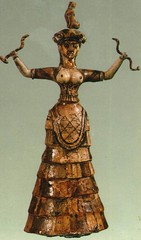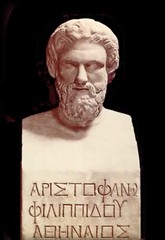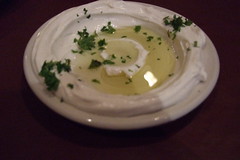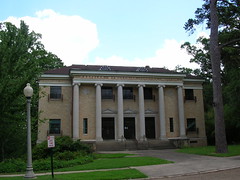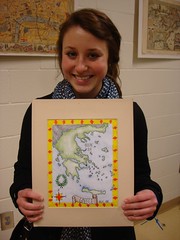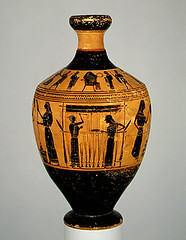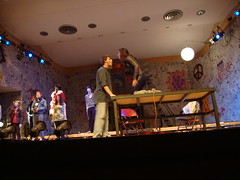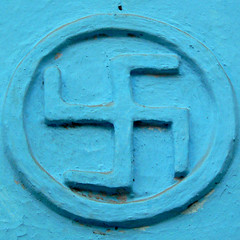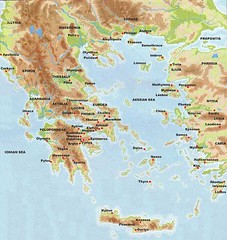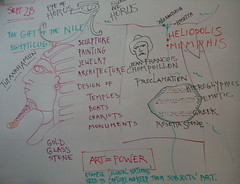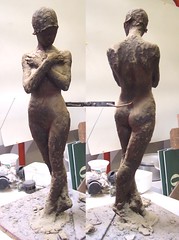The Greek alphabet is a set of twenty-four letters that has been used to write the Greek language since the late 9th or early 8th century BC, says Wikipedia.
It is the first and oldest alphabet in the narrow sense that it notes each vowel and consonant with a separate symbol.[2] It is as such in continuous use to this day. The letters were also used to represent Greek numerals, beginning in the 2nd century BC.
The Greek alphabet is descended from the Phoenician alphabet. It has given rise to many other alphabets used in Europe and the Middle East, including the Latin alphabet.[2]
In addition to being used for writing Modern Greek, its letters are today used as symbols in mathematics and science, as particle names in physics, as components of star names, in the names of fraternities and sororities, in the naming of supernumerary tropical cyclones, and for other purposes.
Wednesday, October 27, 2010
Yeero Yeero, Shreveport
One of several places in Shreveport to visit in exploring cuisine from the Mediterranean, Yeero Yeero is terrifically consistent with its Greek comfort food.
Try it. Try eating inside! Then write about your meal with detailed description and thoughtful evaluation.
Try it. Try eating inside! Then write about your meal with detailed description and thoughtful evaluation.
Tuesday, October 26, 2010
Minoan culture: the wealth and power of Crete preceded the rise of mainland Greece
The Minoans were primarily a mercantile people engaged in overseas trade. Their culture, from 1700 BC onward, shows a high degree of organization, says Wikipedia.
Objects of Minoan manufacture suggest there was a network of trade with mainland Greece (notably Mycenae), Cyprus, Syria, Anatolia, Egypt, Mesopotamia, and westward as far as the coast of Spain.
Minoan men wore loincloths and kilts. Women wore robes that had short sleeves and layered flounced skirts. These were open to the navel allowing their breasts to be left exposed, perhaps during ceremonial occasions.[citation needed] Women also had the option of wearing a strapless fitted bodice, the first fitted garments known in history.[citation needed] The patterns on clothes emphasized symmetrical geometric designs. It must be remembered that other forms of dress may have been worn of which we have no record.
The Minoan religion focused on female deities, with females officiating.[33] The statues of priestesses in Minoan culture and frescoes showing men and women participating in the same sports such as bull-leaping, lead some archaeologists to believe that men and women held equal social status.
Jump to: navigation, search
The Bull-Leaping Fresco from the Great Palace at Knossos, Crete
The bull-leaper, an ivory figurine from the palace of Knossos, Crete. The only complete surviving figure of a larger arrangement of figures. This is the earliest three dimensional representation of the bull leap. It is assumed that thin gold wires were used to suspend the figure over a bull.
Bull-leaping is a motif of Middle Bronze Age figurative art, notably of Minoan Crete, but also found in Hittite Anatolia, the Levant, Bactria and the Indus Valley.[2]
It is often interpreted as a depiction of a ritual performed in connection with bull worship. This ritual consists of an acrobatic leap over a bull; when the leaper grasps the bull's horns, the bull will violently jerk his head upwards giving the leaper the momentum necessary to perform somersaults and other acrobatic tricks or stunts. Bull leaping may have been a rite of passage for young men in Minoan culture.
Objects of Minoan manufacture suggest there was a network of trade with mainland Greece (notably Mycenae), Cyprus, Syria, Anatolia, Egypt, Mesopotamia, and westward as far as the coast of Spain.
Minoan men wore loincloths and kilts. Women wore robes that had short sleeves and layered flounced skirts. These were open to the navel allowing their breasts to be left exposed, perhaps during ceremonial occasions.[citation needed] Women also had the option of wearing a strapless fitted bodice, the first fitted garments known in history.[citation needed] The patterns on clothes emphasized symmetrical geometric designs. It must be remembered that other forms of dress may have been worn of which we have no record.
The Minoan religion focused on female deities, with females officiating.[33] The statues of priestesses in Minoan culture and frescoes showing men and women participating in the same sports such as bull-leaping, lead some archaeologists to believe that men and women held equal social status.
Jump to: navigation, search
The Bull-Leaping Fresco from the Great Palace at Knossos, Crete
The bull-leaper, an ivory figurine from the palace of Knossos, Crete. The only complete surviving figure of a larger arrangement of figures. This is the earliest three dimensional representation of the bull leap. It is assumed that thin gold wires were used to suspend the figure over a bull.
Bull-leaping is a motif of Middle Bronze Age figurative art, notably of Minoan Crete, but also found in Hittite Anatolia, the Levant, Bactria and the Indus Valley.[2]
It is often interpreted as a depiction of a ritual performed in connection with bull worship. This ritual consists of an acrobatic leap over a bull; when the leaper grasps the bull's horns, the bull will violently jerk his head upwards giving the leaper the momentum necessary to perform somersaults and other acrobatic tricks or stunts. Bull leaping may have been a rite of passage for young men in Minoan culture.
A modern plot from an Archaic Greek playwright, Aristophanes
A brief summary of the cynical playwright Aristophanes' play, The Clouds:
Faced with legal action for non-payment of debts, Strepsiades, an elderly Athenian, enrolls his son in The Thinkery (the "Phrontisterion") so that he might learn the rhetorical skills necessary to defeat their creditors in court. The son thereby learns cynical disrespect for social mores and contempt for authority and he subsequently beats his father up during a domestic argument, in return for which Strepsiades sets The Thinkery on fire.
It was a satire at the expense of Socrates and was, said some, damaging to Socrates reputation.
Faced with legal action for non-payment of debts, Strepsiades, an elderly Athenian, enrolls his son in The Thinkery (the "Phrontisterion") so that he might learn the rhetorical skills necessary to defeat their creditors in court. The son thereby learns cynical disrespect for social mores and contempt for authority and he subsequently beats his father up during a domestic argument, in return for which Strepsiades sets The Thinkery on fire.
It was a satire at the expense of Socrates and was, said some, damaging to Socrates reputation.
Thursday, October 21, 2010
Taverna! A Greek meze upon the lawn - with guests! Th, Nov 4
The Greek Taverna picnic.
Changed to Thurs. a week! Nov 4.
Everyone must do something creative.
15 pts; not bonus or indie work.
Dishes may be made by more than one person.
The principal needs include
- hummus dip
- tzatziki dip
- dolmas (dolmades)
- mint tea
- pita bread
- olives
- olive oil
- feta cheese
- Greek salat (onions, lettuce, olives, etc)
- baba ghanoush dip
- moussaka (sim to lasagna)
- patitsio (sim to lasagna)
- baklava
- souvlaki (shish kebab)
- spanikopita (spinach pie)
- panini
- yogurt (natural flavor) with honey
- herbed, buttered boiled potato bites
- koulourakia - butter cookies w almonds
- espresso
- signage - to briefly explain each dish
- folk music - epics and tunes about Homer & the Odyssey
- paper plates, plastic forks supplied by the teacher.
More info: begin with wikipedia at Greek Cuisine.
Changed to Thurs. a week! Nov 4.
Everyone must do something creative.
15 pts; not bonus or indie work.
Dishes may be made by more than one person.
The principal needs include
- hummus dip
- tzatziki dip
- dolmas (dolmades)
- mint tea
- pita bread
- olives
- olive oil
- feta cheese
- Greek salat (onions, lettuce, olives, etc)
- baba ghanoush dip
- moussaka (sim to lasagna)
- patitsio (sim to lasagna)
- baklava
- souvlaki (shish kebab)
- spanikopita (spinach pie)
- panini
- yogurt (natural flavor) with honey
- herbed, buttered boiled potato bites
- koulourakia - butter cookies w almonds
- espresso
- signage - to briefly explain each dish
- folk music - epics and tunes about Homer & the Odyssey
- paper plates, plastic forks supplied by the teacher.
More info: begin with wikipedia at Greek Cuisine.
Art in nature: the importance of the Mediterranean tree called the Olive
The olive is one of the plants most often cited in literature. In Homer's Odyssey, Odysseus crawls beneath two shoots of olive that grow from a single stock,[4] and in the Iliad, (XVII.53ff) is a metaphoric description of a lone olive tree in the mountains, by a spring; the Greeks observed that the olive rarely thrives at a distance from the sea, which in Greece invariably means up mountain slopes.
Greek myth attributed to the primordial culture-hero Aristaeus the understanding of olive husbandry, along with cheese-making and bee-keeping.[5] Olive was one of the woods used to fashion the most primitive Greek cult figures, called xoana, referring to their wooden material; they were reverently preserved for centuries.[6] It was purely a matter of local pride that the Athenians claimed that the olive grew first in Athens.[7] In an archaic Athenian foundation myth, Athena won the patronship of Attica from Poseidon with the gift of the olive.
The leafy branches of the olive tree - the olive leaf as a symbol of abundance, glory and peace - were used to crown the victors of friendly games and bloody wars. As emblems of benediction and purification, they were also ritually offered to deities and powerful figures; some were even found in Tutankhamen's tomb.
Olive oil has long been considered sacred; it was used to anoint kings and athletes in ancient Greece. It was burnt in the sacred lamps of temples as well as being the "eternal flame" of the original Olympic Games. Victors in these games were crowned with its leaves.
Over the years, the olive has been the symbol of peace, wisdom, glory, fertility, power and pureness. The olive tree and olives are mentioned over 30 times in the Bible, in both the New and Old Testaments. It is one of the first plants mentioned in the Bible, and one of the most significant. For example, it was an olive leaf that a dove brought back to Noah to demonstrate that the flood was over.
The olive tree and olive oil are mentioned seven times in the Quran, and the olive is praised as a precious fruit. In Chapter 24 Al-Nur: "Allah is the Light of the heavens and the earth. The metaphor of His Light is that of a niche in which is a lamp, the lamp inside a glass, the glass like a brilliant star, lit from a blessed tree, an olive, neither of the east nor of the west, its oil all but giving off light even if no fire touches it. Light upon Light. Allah guides to His Light whoever He wills and Allah makes metaphors for mankind and Allah has knowledge of all things." (Quran, 24:35). Olive tree and olive oil health benefits have been propounded in Prophetic medicine. The Prophet Mohamed is reported to have said: "Take oil of olive and massage with it - it is a blessed tree" (Sunan al-Darimi, 69:103).
It is estimated the cultivation of olive trees began more than 7000 years ago. As far back as 3000 BC, olives were grown commercially in Crete; they may have been the source of the wealth of the Minoan civilization.[14] The ancient Greeks used to smear olive oil on their bodies and hair as a matter of grooming and good health.
Greek myth attributed to the primordial culture-hero Aristaeus the understanding of olive husbandry, along with cheese-making and bee-keeping.[5] Olive was one of the woods used to fashion the most primitive Greek cult figures, called xoana, referring to their wooden material; they were reverently preserved for centuries.[6] It was purely a matter of local pride that the Athenians claimed that the olive grew first in Athens.[7] In an archaic Athenian foundation myth, Athena won the patronship of Attica from Poseidon with the gift of the olive.
The leafy branches of the olive tree - the olive leaf as a symbol of abundance, glory and peace - were used to crown the victors of friendly games and bloody wars. As emblems of benediction and purification, they were also ritually offered to deities and powerful figures; some were even found in Tutankhamen's tomb.
Olive oil has long been considered sacred; it was used to anoint kings and athletes in ancient Greece. It was burnt in the sacred lamps of temples as well as being the "eternal flame" of the original Olympic Games. Victors in these games were crowned with its leaves.
Over the years, the olive has been the symbol of peace, wisdom, glory, fertility, power and pureness. The olive tree and olives are mentioned over 30 times in the Bible, in both the New and Old Testaments. It is one of the first plants mentioned in the Bible, and one of the most significant. For example, it was an olive leaf that a dove brought back to Noah to demonstrate that the flood was over.
The olive tree and olive oil are mentioned seven times in the Quran, and the olive is praised as a precious fruit. In Chapter 24 Al-Nur: "Allah is the Light of the heavens and the earth. The metaphor of His Light is that of a niche in which is a lamp, the lamp inside a glass, the glass like a brilliant star, lit from a blessed tree, an olive, neither of the east nor of the west, its oil all but giving off light even if no fire touches it. Light upon Light. Allah guides to His Light whoever He wills and Allah makes metaphors for mankind and Allah has knowledge of all things." (Quran, 24:35). Olive tree and olive oil health benefits have been propounded in Prophetic medicine. The Prophet Mohamed is reported to have said: "Take oil of olive and massage with it - it is a blessed tree" (Sunan al-Darimi, 69:103).
It is estimated the cultivation of olive trees began more than 7000 years ago. As far back as 3000 BC, olives were grown commercially in Crete; they may have been the source of the wealth of the Minoan civilization.[14] The ancient Greeks used to smear olive oil on their bodies and hair as a matter of grooming and good health.
Wednesday, October 20, 2010
Karpeles Manuscript Library Museum / Shreveport
Your once-a-month Fine Arts Experience papers - at 12 pts each - can be written about a wide range of topics -
- a meal at an ethnic, independent restaurant (please check w me)
- an indie movie (low budget, non mass-market, artistic in direction), preferably at Robinson Film Center.
- performance of a drama or comedy or musical.
- concert by an orchestra or opera troupe.
- concert by a non mass-market, artistic pop unit.
- visit to a museum or gallery featuring artistic displays (any museum in town, from a repeat visit to Norton to the La State Exhibit Museum).
The theme is to get out of your usual pathway and experience the artistic offerings that enrich life in an urban center.
You must follow the review guidelines posted at fineartsmagnet.blogspot.com. To write from the top of your head does not represent growth in the skill of composition. Find and follow the class guidelines.
- a meal at an ethnic, independent restaurant (please check w me)
- an indie movie (low budget, non mass-market, artistic in direction), preferably at Robinson Film Center.
- performance of a drama or comedy or musical.
- concert by an orchestra or opera troupe.
- concert by a non mass-market, artistic pop unit.
- visit to a museum or gallery featuring artistic displays (any museum in town, from a repeat visit to Norton to the La State Exhibit Museum).
The theme is to get out of your usual pathway and experience the artistic offerings that enrich life in an urban center.
You must follow the review guidelines posted at fineartsmagnet.blogspot.com. To write from the top of your head does not represent growth in the skill of composition. Find and follow the class guidelines.
Tuesday, October 19, 2010
Mult-choice, open notes quiz on Greece and Egypt first block Oct 26-27
A quiz of around 21 questions will review web site notes on both Egypt and Greece.
Web site notes through Sat, Oct 23.
Web site notes through Sat, Oct 23.
Topics in historic Greek art for a basic digital image-based report
Please present the basics on each topic via 5 images -, each w 2 or 3 bulleted items of info. Due a week from today. 10 pts.
1. Crete
2. Mycenae
3. Sparta
4. Olympia
5. Olympic games
6. Archaic period
7. Classic period
8. Athens
9. Pericles
10. Homer
11. Sappho
12. symposium
13. Academy & Lyceum
14. Socrates
15. Plato
16. Aristotle
17. Sophists
18. Epicureans
19. Stoics
20. Greek drama
21. Greek amphitheater & stage
22. Herodotus
23. Aristophanes
24. Sophocles
25. Aristophanes
26. tragedy & comedy
27. Aesclepius
28. Alexander the Great
29. Hellenistic era
30. Roman empire / Greece
31. Greek Orthodox Church
32. Byzantine Empire
33. Greek cuisine
1. Crete
2. Mycenae
3. Sparta
4. Olympia
5. Olympic games
6. Archaic period
7. Classic period
8. Athens
9. Pericles
10. Homer
11. Sappho
12. symposium
13. Academy & Lyceum
14. Socrates
15. Plato
16. Aristotle
17. Sophists
18. Epicureans
19. Stoics
20. Greek drama
21. Greek amphitheater & stage
22. Herodotus
23. Aristophanes
24. Sophocles
25. Aristophanes
26. tragedy & comedy
27. Aesclepius
28. Alexander the Great
29. Hellenistic era
30. Roman empire / Greece
31. Greek Orthodox Church
32. Byzantine Empire
33. Greek cuisine
Sunday, October 17, 2010
Vocal power and kinetic verve: Shreveport Little Theater Academy's production of Rent
Isaac Haas, in profile, threw his large eyes upon Erin Davis, petite but also large of eyes. Their melodies alternated - both have strong, sweet voices - and then blended into a melodious cat's howl.
It was the Shreveport Little Theater Academy's production of Rent on Saturday night, where expressions exploded and the singing was super.
Director Jared Watson has taken a group of talented and handsome teens, found their strengths and cast them like butter into a sautee pan.
Zhailon Levingston threw himself around the stage and molded his rich voice to numerous melodies. Gentry Williams, too, beamed and crooned with capable abandon.
Anchoring the stage with a voice so righteous it rolls effortlessly from blues to opera was Emily Mwakitawa. Following in her vocal footsteps were Emma Foreman and Wallace Rakoczy, both passionate young wailers.
Kaelon Gerard, a tall lad with thick vocal timbre, was, like all the principals, able to trippingly dance across the stage while hitting his notes.
Yet a major component was missing from this version of Rent: no band. The excellent ensemble that SLTA has used under music director Adam Philley was caught in a schedule conflict, explained director Watson.
What a shame, not to pick up a substitute group of musicians!
Rent is a not an easy show for a teen cast. It's a story of poverty, prostitution, hard drugs, death - and life before texting. Rent also has a complex storyline. Reading the outline before seeing the show would not be a waste of time.
Teens want a show that reflects their striving for independence. Watson explained that, "This is the show these kids really wanted to do." And if there's a full measure of raunch, there's also a positive side to Rent: it glorifies friendship, loyalty, community and endurance.
In the end, this production of Rent is notable for vocal power and kinetic entertainment.
Even without live music it offers a worthy evening of entertainment.
It was the Shreveport Little Theater Academy's production of Rent on Saturday night, where expressions exploded and the singing was super.
Director Jared Watson has taken a group of talented and handsome teens, found their strengths and cast them like butter into a sautee pan.
Zhailon Levingston threw himself around the stage and molded his rich voice to numerous melodies. Gentry Williams, too, beamed and crooned with capable abandon.
Anchoring the stage with a voice so righteous it rolls effortlessly from blues to opera was Emily Mwakitawa. Following in her vocal footsteps were Emma Foreman and Wallace Rakoczy, both passionate young wailers.
Kaelon Gerard, a tall lad with thick vocal timbre, was, like all the principals, able to trippingly dance across the stage while hitting his notes.
Yet a major component was missing from this version of Rent: no band. The excellent ensemble that SLTA has used under music director Adam Philley was caught in a schedule conflict, explained director Watson.
What a shame, not to pick up a substitute group of musicians!
Rent is a not an easy show for a teen cast. It's a story of poverty, prostitution, hard drugs, death - and life before texting. Rent also has a complex storyline. Reading the outline before seeing the show would not be a waste of time.
Teens want a show that reflects their striving for independence. Watson explained that, "This is the show these kids really wanted to do." And if there's a full measure of raunch, there's also a positive side to Rent: it glorifies friendship, loyalty, community and endurance.
In the end, this production of Rent is notable for vocal power and kinetic entertainment.
Even without live music it offers a worthy evening of entertainment.
Thursday, October 14, 2010
Ethnocentrism and the Swastika
This swastika is on a house in Jamalpur, Bihar, India, writes the photographer. The swastika is an ancient symbol representing permanent spiritual victory.
The photojournalist continues, "I have seen so many swastikas here in India - on temples, houses, shops, rickshaws and in random, unexpected places - that they just seem very commonplace to me now. This is very far from the shocking reaction that the symbol often receives in the West, due to the history of its abuse there. That negative perception is absolutely absent from people's minds here. The swastika here represents goodness, righteousness, truth, purpose and divinity."
Somehow your teacher is going to leap from the swastika to ethnocentrism.
Ethnocentrism is the tendency to believe that one's ethnic or cultural group is centrally important, and that all other groups are measured in relation to one's own.
People of the following nations are known for their ethnocentrism:
Americans
French
Italians
Russians
Chinese
One form of ethnocentrism is nationalism. A certain amount of nationalism is considered healthy. Radical nationalism may be barbarous.
When Americans judge the swastika to be a symbol of evil Nazi corruption, are they being ethnocentric? No. They're simply showing their lack of education.
The photojournalist continues, "I have seen so many swastikas here in India - on temples, houses, shops, rickshaws and in random, unexpected places - that they just seem very commonplace to me now. This is very far from the shocking reaction that the symbol often receives in the West, due to the history of its abuse there. That negative perception is absolutely absent from people's minds here. The swastika here represents goodness, righteousness, truth, purpose and divinity."
Somehow your teacher is going to leap from the swastika to ethnocentrism.
Ethnocentrism is the tendency to believe that one's ethnic or cultural group is centrally important, and that all other groups are measured in relation to one's own.
People of the following nations are known for their ethnocentrism:
Americans
French
Italians
Russians
Chinese
One form of ethnocentrism is nationalism. A certain amount of nationalism is considered healthy. Radical nationalism may be barbarous.
When Americans judge the swastika to be a symbol of evil Nazi corruption, are they being ethnocentric? No. They're simply showing their lack of education.
Riace bronzes, classic Greek sculpture, displayed in the Reggio Calabria Museum of Italy
Most Greek sculpture is known through later Roman copies in marble.
The Riace bronzes are original, says Wikipedia.
The statues' eyes are inlaid with bone and glass, while the teeth are in silver and lips and nipples are in copper. Formerly they held spears and shields. Additionally, Riace Warrior B once wore a helmet pushed up atop his head, and it is thought that Riace Warrior A perhaps wore a wreath over his.[3] The Bronzi, outstanding examples of ancient Greek sculpture, belong to a transitional period from archaic Greek sculpture to the early Classic style, disguising their idealized geometry and impossible anatomy (Spivey 2005) under a distracting and alluring "realistic" surface.
These bronzes are from the early Classical Period, made about 445 BCE. They are a fine example of contrapposto - the weight is on the back legs and is much more realistic than Archaic stances. The musculature is clear yet not incised and looks soft enough to be visible yet realistic. The turned head not only represents movement but also adds life to the sculptures. The asymmetrical layout of the arms and legs serves to add to the realism.
The Riace bronzes are original, says Wikipedia.
The statues' eyes are inlaid with bone and glass, while the teeth are in silver and lips and nipples are in copper. Formerly they held spears and shields. Additionally, Riace Warrior B once wore a helmet pushed up atop his head, and it is thought that Riace Warrior A perhaps wore a wreath over his.[3] The Bronzi, outstanding examples of ancient Greek sculpture, belong to a transitional period from archaic Greek sculpture to the early Classic style, disguising their idealized geometry and impossible anatomy (Spivey 2005) under a distracting and alluring "realistic" surface.
These bronzes are from the early Classical Period, made about 445 BCE. They are a fine example of contrapposto - the weight is on the back legs and is much more realistic than Archaic stances. The musculature is clear yet not incised and looks soft enough to be visible yet realistic. The turned head not only represents movement but also adds life to the sculptures. The asymmetrical layout of the arms and legs serves to add to the realism.
Spartans, the militaristic city-state that won the Peloponnesian Wars
Sparta, the great military state, was recognized as the overall leader of the combined Greek forces during the Greco-Persian Wars.[2], says Wikipedia.
Between 431 and 404 BC, Sparta was the principal enemy of Athens during the Peloponnesian War,[3] from which it emerged victorious, though at great cost.
Sparta maintained its political independence until 146 BC, when the Romans conquered Greece.
Sparta was unique in ancient Greece for its social system and constitution, which completely focused on military training and excellence.
Its inhabitants were classified as Spartiates (Spartan citizens, who enjoyed full rights), Mothakes (non-Spartan free men raised as Spartans), Perioikoi (freedmen), and Helots (state-owned serfs, enslaved non-Spartan local population). Spartiates underwent the rigorous agoge training and education regimen, and Spartan phalanxes were widely considered to be among the best in battle. Spartan women enjoyed considerably more rights and equality to men than elsewhere in the classical world.
The Spartans were a minority of the Lakonian population. The largest class of inhabitants were the helots (in Classical Greek Εἵλωτες / Heílôtes).[32][33]
The helots were originally free Greeks from the areas of Messenia and Lakonia whom the Spartans had defeated in battle and subsequently enslaved. In other Greek city-states, free citizens were part-time soldiers who, when not at war, carried on other trades. Since Spartan men were full-time soldiers, they were not available to carry out manual labour.[34] The helots were used as unskilled serfs, tilling Spartan land. Helot women were often used as wet nurses. Helots also travelled with the Spartan army as non-combatant serfs.
When male Spartans began military training at age seven, they would enter the Agoge system. The Agoge was designed to encourage discipline and physical toughness and to emphasise the importance of the Spartan state. Boys lived in communal messes and were deliberately underfed, to encourage them to master the skill of stealing food. Besides physical and weapons training, boys studied reading, writing, music and dancing. Special punishments were imposed if boys failed to answer questions sufficiently 'laconically' (i.e. briefly and wittily).[55] At the age of twelve, the Agoge obliged Spartan boys to take an older male mentor, usually an unmarried young man. The older man was expected to function as a kind of substitute father and role model to his junior partner; however, it is also reasonably certain that they had sexual relations (the exact nature of Spartan pederasty is not entirely clear).[56]
The pattern above is the famous Greek Key. It is often seen in friezes and other borders.
Between 431 and 404 BC, Sparta was the principal enemy of Athens during the Peloponnesian War,[3] from which it emerged victorious, though at great cost.
Sparta maintained its political independence until 146 BC, when the Romans conquered Greece.
Sparta was unique in ancient Greece for its social system and constitution, which completely focused on military training and excellence.
Its inhabitants were classified as Spartiates (Spartan citizens, who enjoyed full rights), Mothakes (non-Spartan free men raised as Spartans), Perioikoi (freedmen), and Helots (state-owned serfs, enslaved non-Spartan local population). Spartiates underwent the rigorous agoge training and education regimen, and Spartan phalanxes were widely considered to be among the best in battle. Spartan women enjoyed considerably more rights and equality to men than elsewhere in the classical world.
The Spartans were a minority of the Lakonian population. The largest class of inhabitants were the helots (in Classical Greek Εἵλωτες / Heílôtes).[32][33]
The helots were originally free Greeks from the areas of Messenia and Lakonia whom the Spartans had defeated in battle and subsequently enslaved. In other Greek city-states, free citizens were part-time soldiers who, when not at war, carried on other trades. Since Spartan men were full-time soldiers, they were not available to carry out manual labour.[34] The helots were used as unskilled serfs, tilling Spartan land. Helot women were often used as wet nurses. Helots also travelled with the Spartan army as non-combatant serfs.
When male Spartans began military training at age seven, they would enter the Agoge system. The Agoge was designed to encourage discipline and physical toughness and to emphasise the importance of the Spartan state. Boys lived in communal messes and were deliberately underfed, to encourage them to master the skill of stealing food. Besides physical and weapons training, boys studied reading, writing, music and dancing. Special punishments were imposed if boys failed to answer questions sufficiently 'laconically' (i.e. briefly and wittily).[55] At the age of twelve, the Agoge obliged Spartan boys to take an older male mentor, usually an unmarried young man. The older man was expected to function as a kind of substitute father and role model to his junior partner; however, it is also reasonably certain that they had sexual relations (the exact nature of Spartan pederasty is not entirely clear).[56]
The pattern above is the famous Greek Key. It is often seen in friezes and other borders.
Tuesday, October 12, 2010
The Paper Parthenon atop the Acropolis
Grecian art, or Hellenistic art -
Greek excellence in architecture has touched the world in the almost 3 centuries following their 450 BCE Golden Era.
Pericles was sort of their George Washington. Pericles led the Athenians in military success, in trading at sea and directed the building of the Parthenon.
The temple of Athena Parthenos (parthenogenesis, "virgin birth")
is the largest of numerous temples atop the mesa called the Acropolis (acro, "high," see acrophobia, "fear of heights"). It is one of the few great cities named for a goddess.
The Doric columns (Ionic and Corinthian columns are more elaborate)
are topped by a decorative band called a frieze. Above the frieze is the pediment, which represents the footing of the roof.
Inside was a 40-foot ivory and gold statue of Athena.
The relief sculptures in the pediment brought to life the struggle of Athena and Poseidon. Those marble sculptures now reside in the British Museum, London (and are referred to as the Elgin Marbles). The Greeks are asking that the work be repatriated - brought back to its fatherland. So far the English government has demurred.
Students are using rolled paper columns and thick pediments and frieze to bring the Parthenon to life with unusual texture.
The project, with identifications of all parts and a map of the Greek Empire, is worth 5 points.
Students will also write a 9-question, multiple-choice quiz to cover the terminology.
Before the end of next week they must teach the lesson of the Parthenon to 3 people.
- Record their answers and the score.
- Have the pupil sign and write a brief profile, such as "Brian Beeler, age 45, electrician."
- Quiz and 3 sets of results: 15 pts.
The educational theme: "if you want to learn a thing, teach it."
Greek excellence in architecture has touched the world in the almost 3 centuries following their 450 BCE Golden Era.
Pericles was sort of their George Washington. Pericles led the Athenians in military success, in trading at sea and directed the building of the Parthenon.
The temple of Athena Parthenos (parthenogenesis, "virgin birth")
is the largest of numerous temples atop the mesa called the Acropolis (acro, "high," see acrophobia, "fear of heights"). It is one of the few great cities named for a goddess.
The Doric columns (Ionic and Corinthian columns are more elaborate)
are topped by a decorative band called a frieze. Above the frieze is the pediment, which represents the footing of the roof.
Inside was a 40-foot ivory and gold statue of Athena.
The relief sculptures in the pediment brought to life the struggle of Athena and Poseidon. Those marble sculptures now reside in the British Museum, London (and are referred to as the Elgin Marbles). The Greeks are asking that the work be repatriated - brought back to its fatherland. So far the English government has demurred.
Students are using rolled paper columns and thick pediments and frieze to bring the Parthenon to life with unusual texture.
The project, with identifications of all parts and a map of the Greek Empire, is worth 5 points.
Students will also write a 9-question, multiple-choice quiz to cover the terminology.
Before the end of next week they must teach the lesson of the Parthenon to 3 people.
- Record their answers and the score.
- Have the pupil sign and write a brief profile, such as "Brian Beeler, age 45, electrician."
- Quiz and 3 sets of results: 15 pts.
The educational theme: "if you want to learn a thing, teach it."
Monday, October 11, 2010
Mickey Finns @ Centenary Shell on Tues, Oct 12
Have you written your review of a Fine Arts Experience for September?
This Tuesday night free show of Celtic rock would qualify as a good subject.
This Tuesday night free show of Celtic rock would qualify as a good subject.
Ancient Greece: the Top Fifteen
Most important sites from the ancient map of Graecia -
Athens
Sparta
Peloponnesus peninsula
Olympia temple complex
Thebes
Delphi
Mt Olympus
Mycenae
Crete
Aegean Sea
Macedonia
Ilium
Troy
Lesbos
Ephesus
Thursday, October 7, 2010
12 items on a sketched map of Egypt: map quiz next week
And students must spell Mediterranean and Israel correctly or face a loss of 1 pt each on the misspelling.
Tuesday, October 5, 2010
A one-third size preliminary study for a statue of Primavera - a wax maquette
A maquette (French word for scale model, sometimes referred to by the Italian names plastico or modello) is a small scale model or rough draft of an unfinished architectural work or a sculpture. An equivalent term is bozzetto, from the Italian word that means "sketch".
It is used to visualize and test shapes and ideas without incurring the cost and effort of producing a full scale product. It is the analogue of the painter's cartoon, modello, oil sketch or drawn sketch.
For commissioned sculptures, especially monumental public sculptures, a maquette may be used to show the client how the finished work will fit in the proposed site. The term may also refer to a prototype for a video game, film, or any other type of media. Modello, unlike the other terms, is also used for sketches for two-dimensional works such as paintings.
Like oil sketches, these works in progress can be at least as much sought after as completed works by highly regarded artists, showing the process of developing an idea. Gian Lorenzo Bernini, a sculptor from the Baroque period, made his bozzetti from wax or baked terracotta to show his patrons how the final piece was intended to look. Eleven of these bozzetti were displayed in an exhibition at the Art Institute of Chicago in 2004.[1]
It is used to visualize and test shapes and ideas without incurring the cost and effort of producing a full scale product. It is the analogue of the painter's cartoon, modello, oil sketch or drawn sketch.
For commissioned sculptures, especially monumental public sculptures, a maquette may be used to show the client how the finished work will fit in the proposed site. The term may also refer to a prototype for a video game, film, or any other type of media. Modello, unlike the other terms, is also used for sketches for two-dimensional works such as paintings.
Like oil sketches, these works in progress can be at least as much sought after as completed works by highly regarded artists, showing the process of developing an idea. Gian Lorenzo Bernini, a sculptor from the Baroque period, made his bozzetti from wax or baked terracotta to show his patrons how the final piece was intended to look. Eleven of these bozzetti were displayed in an exhibition at the Art Institute of Chicago in 2004.[1]
Subscribe to:
Posts (Atom)
